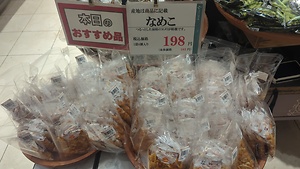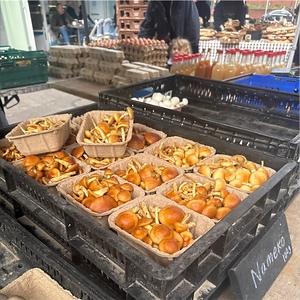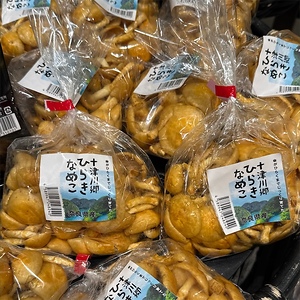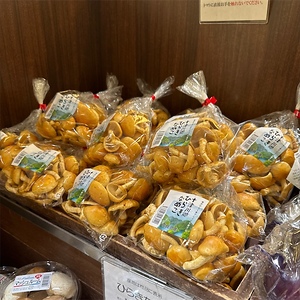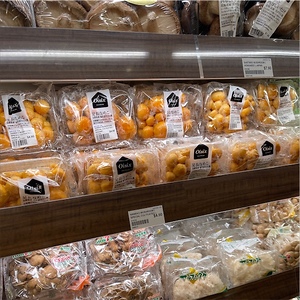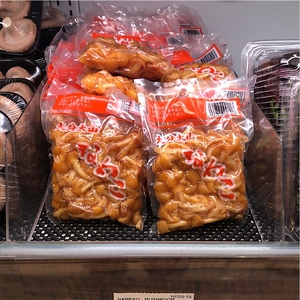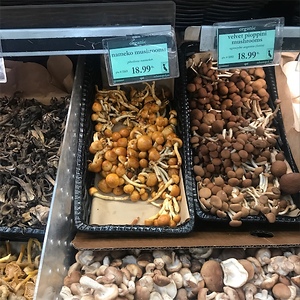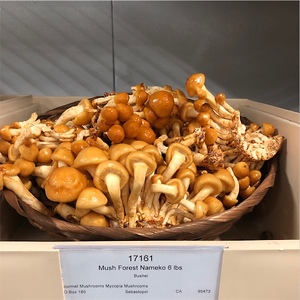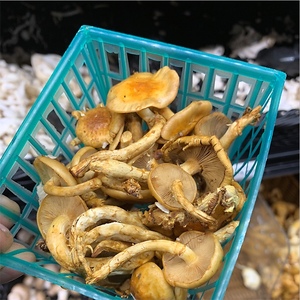

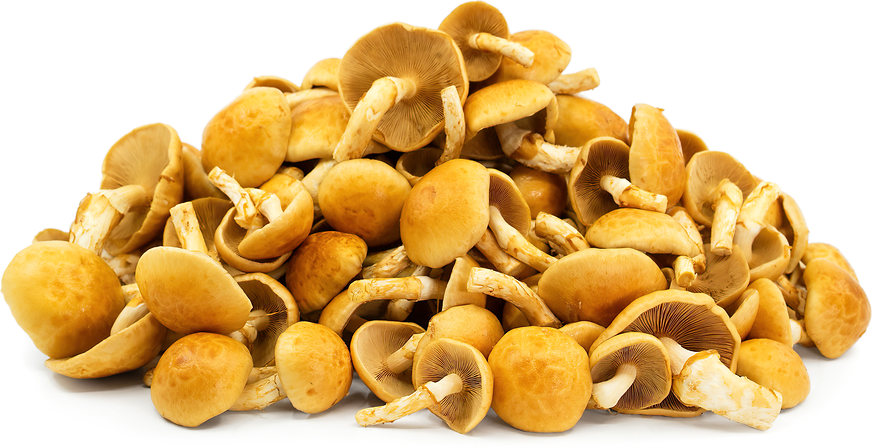
Nameko Mushrooms
Estimated Inventory, lb : 0
Description/Taste
Nameko mushrooms grow in crowded clusters of small to medium-sized caps attached to slender, straight stems. Each cap averages 2 to 8 centimeters in diameter and the stems 5 to 7 centimeters in length, and the smooth, rounded caps showcase amber, chestnut brown, to orange-brown hues. The caps are also coated in natural substances that give the surface a glossy, slippery, and somewhat viscous feel. As the caps mature, their domed, curved shape will flatten and flare at the edges. Underneath the cap, there are light yellow to white gills that produce cinnamon-colored spores, and the white stems are springy, pliable, and thin. Nameko mushrooms cannot be eaten raw and must be cooked before consumption. The mushrooms release a sweet, candy-like aroma reminiscent of butterscotch and develop a firm but slippery and gelatinous mouthfeel when cooked. Nameko mushrooms have an earthy, woody, and nutty taste with sweet, subtly fruity nuances.
Seasons/Availability
Wild Nameko mushrooms are available in the fall through winter, while the cultivated versions are available year-round.
Current Facts
Nameko mushrooms, botanically classified as Pholiota microspora, are a wild and cultivated species belonging to the Strophariaceae family. The mushrooms are one of Japan's most popular culinary varieties, falling just behind shiitake mushrooms, and are valued for their slippery, gelatinous nature. The name Nameko was derived from the Japanese word "Numerikko," roughly translating to "slimy mushrooms." "Numeri" means "slimy" or "slime," and "ko" was taken from "kinoko," meaning mushroom. Numerikko was eventually shortened to Nameko, the most used moniker for the mushroom, and the variety has acquired several other names, including Namesugitake, Nametake, Forest Nameko, and Forest mushroom. In the United States, Nameko was renamed for its sweet, candy-like aroma, labeled as Butterscotch mushrooms. Nameko mushrooms were once only foraged from the wild, but in the present-day, commercial cultivation has exceeded wild populations to meet increasing culinary demand. There are two main types of cultivated Nameko mushrooms sold in Japanese commercial markets: Kabutori Nameko and Foot-Cut Nameko. Kabutori Nameko still has the stem still attached to the cap, while Foot-Cut Nameko mushrooms are only sold with the caps. There are also Jumbo Nameko varieties promoted for their large, less gelatinous nature, favored for steamed and grilled preparations. Nameko mushrooms can be found in fresh, dried, and canned forms, utilized in savory preparations throughout Japan. Outside of Japan, the mushroom variety is grown as a delicacy and is used as a flavoring and textural enhancement.
Nutritional Value
Nameko mushrooms are a source of potassium to balance fluid levels within the body, fiber to regulate the digestive tract, and magnesium to control optimal nerve functioning. The mushrooms also provide vitamin D to assist with calcium absorption, copper to develop connective tissues, and other nutrients, including iron, B vitamins, and phosphorus. The slippery coating on Nameko mushrooms is created from the presence of a natural layer of mucin and pectin. This layer protects the mushrooms from cold weather and drying out, and pectin is believed to help coat the mucous membranes in our bodies. Pectin is also thought to reduce to amount of sugar and cholesterol absorption, and in Japan, the slimy consistency is viewed as nourishing.
Applications
Nameko mushrooms have an earthy, nutty, and woodsy flavor suited for cooked preparations. The mushrooms cannot be consumed raw and can cause poisoning or extreme indigestion if eaten fresh. It is also important to note that the slimy coating on the mushrooms should be left intact to thicken dishes. If dirt needs to be removed from the caps, try gently wiping or briefly running under cold water to remove the particles. The longer the mushrooms are left in water, the more their slippery coating will be removed. Nameko mushrooms are popularly blanched, sauteed, or grilled, and they can be cooked and mixed into rice porridge, combined with miso butter and whipped tofu on toast, or added to noodle dishes for texture and flavor. The mushrooms can also be served with fried tofu, used as a thickener in soups, stews, and sauces, or roasted or grilled and used as an accompaniment to meat main dishes. In Japan, Nameko mushrooms are added to nabemono, a one-pot stew, served with steamed rice, wrapped in sushi rolls, mixed into stir-fries, or combined with daikon radish and ponzu sauce as a side dish. In addition to Asian recipes, Nameko mushrooms can be used as a mushroom variation in pasta, risotto, and as a topping over pizza, or they can be chopped into salsa. Try grilling or sautéing the mushrooms and serving them on charcuterie boards with crostini, soft cheeses, nuts, and olives. Nameko mushrooms pair well with meats such as poultry, game, steak, and fish, tofu, aromatics including shallots, garlic, and onion, nori, cabbage, bean sprouts, and carrots. Whole, unwashed Nameko mushrooms will keep for 1 to 2 days when stored in a sealed container in the refrigerator. It is recommended to use the mushrooms immediately after purchase for the best quality and flavor.
Ethnic/Cultural Info
Nameko mushrooms are famously incorporated into miso soup in Japan. The small mushrooms act as a natural thickener in the soup and provide subtle flavoring and texture to enhance the dish. Miso soup can be traced back to the Kamakura period, from 1185 CE to 1333 CE, when Buddhist monks from China brought suribachi mortars to Japan. Miso, in general, was introduced from China to Japan during the Heian period, from 794 CE to 1185 CE, and was typically served as a thick spread, consumed in pieces, or licked. The paste was created from a mixture of soybeans, salt, water, and koji, a type of fermented rice, and initially, miso was exclusively served to nobility and wealthy families. In the Kamakura period, Buddhist monks discovered that miso could be finely ground into a powder using the suirbachi mortars and dissolved in water or a dashi made from dried sardines, kelp, miso, and other flavorings. Miso soup was a favorite meal of the samurai in the Kamakura period, as the dish was simple to prepare but was believed to provide energy and stamina. By the mid-14th century, miso became available to the masses, and miso soup quickly spread as an everyday staple accompaniment to meals. In the modern day, miso soup is made with additional ingredients in Japan, including tofu, mushrooms, spinach, and onions, for added flavor and texture. Nameko mushrooms are one of the most popular mushrooms to add to miso soup and provide a slippery consistency highly valued among Japanese consumers.
Geography/History
Nameko mushrooms are native to Asia, mainly found in forests in China, Japan, and Taiwan, and have been growing wild since ancient times. The variety is primarily utilized in Japan, and much of its history is documented from a Japanese perspective. Historically, Nameko mushrooms were foraged from forests and grew in compact clusters of slippery mushrooms on the stumps and fallen trunks of beech and oak hardwood trees. The mushrooms were commonly discovered in the Tohoku mountains in Japan and were considered a rare delicacy for many years. Over time, Nameko mushrooms were examined for possible commercial production, and cultivation was estimated to have begun in the Taisho period, from 1912 CE to 1926 CE. Commercially cultivated Nameko mushrooms are grown on logs or in sawdust and share a similar flavor profile to wild Nameko mushrooms. Today Nameko mushrooms are commercially produced year-round in the Niigata, Yamagata, and Nagano Prefectures in Japan and are seasonally foraged from the wild in the fall through winter. Outside of Japan, Nameko mushrooms can be grown in homes through select cultivation kits, and a few specialty growers produce the variety as a delicacy in North American and European markets. In the United States, Nameko mushrooms are grown in Southern California and are offered directly from the grower, through distributors, and through select fresh markets.
Recipe Ideas
Recipes that include Nameko Mushrooms. One
Podcast



